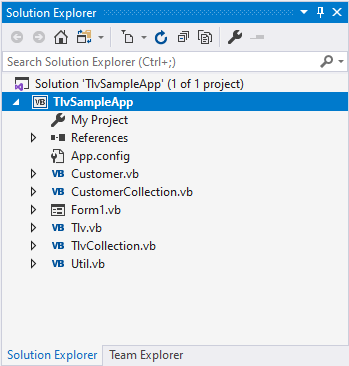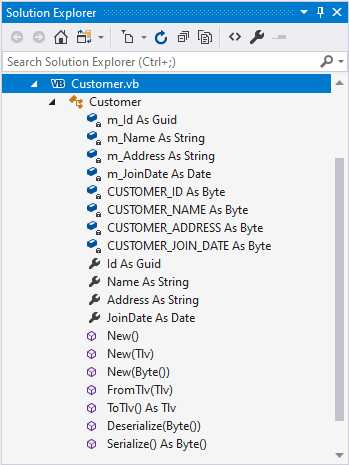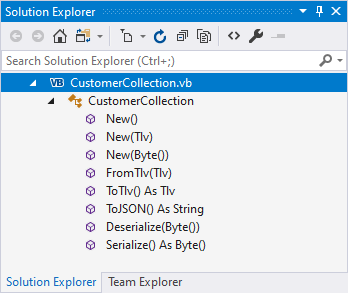Work
Home | Work | Play | Photos | Contact | About
Type-Length-Value - An XML/JSON Alternative
Home \ Work \ Type-Length-Value
Introduction
The problem I've been trying to solve is to find a data format that lets me efficiently send any kind of data over a network. Transmission needs to be efficient, as even in this time of Internet everywhere, networks can be unreliable and slow. I also want to process data before sending it - specifically, compression and encryption. XML and JSON are both really popular and useful ways to represent data. Each have benefits - some of which are shared. Each also have shortcomings, which make them... non-ideal.
The biggest issue I have with XML is that it's verbose. It bundles a ton of meta data with the data itself. Whilst I have other problems with XML (namespaces, the role of CDATA, DTDs), that in itself discounts it.
JSON also has limitations. It only supports a small number of data types, so no dates or byte arrays (BSON supports byte arrays and dates, but not universal numbers). Most uses of JSON have an implicit schema, which adds to the amount of data being transferred. Granted, not nearly as much as XML, but still more than is required when both ends of an exchange already know what they're exchanging.
At Nokia I discovered TLV (Type, Length, Value) - a format that can encode virtually any data. We used it to transmit maps and driving directions to phones. As its name implies, TLV elements consist of three fields -
- Type - A code which indicates the kind/type of data in the value field.
- Length - The size of the value field.
- Value - The data being encoded.
The value field can contain anything. The Type field could, for example, be used to identify a data type (string, integer, date, and so on). It could be used to identify a field type, such as Customer Id or Customer Name. It is as you wish. This flexibility is what gives TLV another advantage over formats like XML and JSON - beyond the Type field, TLV does not include any field meta data, resulting in smaller data payloads.
Multiple TLV elements can be assembled as a sequence, forming a record, or row of data. TLV can do nesting, so a sequence of TLV elements can itself be represented as a single TLV element. Some advantages of using a TLV representation:
- TLV sequences are easily searched using generalized parsing functions.
- Unknown TLV elements can be skipped, and the rest of the sequence parsed with no ill effects. This is similar to the way that unknown XML tags can be safely skipped.
- TLV elements can be placed in any order inside the sequence.
- TLV is ideal for binary data, which makes parsing faster and the data smaller.
- TLV doesn't require libraries, and it's quick to implement. I was transmitting TLV in less than a day (see below).
As you can imagine, TVL is no silver bullet either. It has baggage:
- Data in TLV elements is represented using a single type, such as character or byte arrays. It must be converted from and to it's native format when serialized or deserialized.
- TLV implemented using byte arrays isn't human-readable, in the way that both XML and JSON are.
- It isn't self-describing in the way that XML is. Both parties in an exchange of a TVL sequence must have prior knowledge of element types.
- Nesting must similarly be understood by both parties.
Happily these disadvantages don't affect the way I use TLV. I've no need to see the contents of what's transmitted (encryption will kill that benefit off anyway). I use TLV to exchange data between clients and servers that form part of the same system, so I use the same code to serialize and deserialize TLV on both client and server.
Implementation
By way of example, here's an application that proves the concept simply by serializing a list of customers to both a TLV element and a byte array, and desrializing back to the customer list. The sample app is a Windows Forms application written in Visual Basic.NET, and consists of the following:

Scroll to the bottom to download the source code.
Tlv.vb (TLV Element)
The following code listing shows a class describing a TLV element, and how it might encode and decode a byte array (click the little +/- signs to expand and collapse code blocks):
Option Explicit On
Option Strict On
Public NotInheritable Class Tlv
|
|
#Region "Private instance attributes" |
|
Private m_Type As Byte Private m_Value As Byte() #End Region |
|
#Region "Public instance attributes" |
|
Public Property Type() As Byte Get Return m_Type End Get Set(ByVal value As Byte) If value >= 0 And value <= 255 Then m_Type = value End If End Set End Property Public ReadOnly Property Length() As Integer Get If value Is Nothing Then Return 0 Else Return m_Value.Length End If End Get End Property Public Property Value() As Byte() Get Return m_Value End Get Set(ByVal value As Byte()) m_Value = value End Set End Property #End Region |
|
#Region "Constructors" |
|
' Default constructor. Public Sub New() MyBase.New() End Sub ' Instantiates a TLV element with the specified type and value. Public Sub New(ByVal type As Byte, ByVal value() As Byte) MyBase.New() m_Type = type m_Value = value End Sub ' Decodes the specified byte array into a TLV element. Public Sub New(ByVal value() As Byte) MyBase.New() FromByteArray(value) End Sub #End Region |
|
#Region "Private instance methods" |
|
' Deserializes a Tlv element from a byte array. Private Sub FromByteArray(ByVal bytes() As Byte) Dim _Length As Integer = BitConverter.ToInt32(bytes, 1) m_Type = bytes(0) ReDim m_Value(_Length - 1) Array.Copy(bytes, 5, m_Value, 0, _Length) End Sub #End Region |
|
#Region "Public instance methods" |
|
' Serializes the Tlv element to a byte array. Public Function ToByteArray() As Byte() Dim _ByteArray(m_Value.Length - 1 + 5) As Byte ' Length - 1 + (one byte for type + four bytes for length). Dim _LengthAsBytes() As Byte = BitConverter.GetBytes(m_Value.Length) _ByteArray(0) = m_Type _LengthAsBytes.CopyTo(_ByteArray, 1) m_Value.CopyTo(_ByteArray, 5) Return _ByteArray End Sub #End Region |
|
End Class |
TlvCollection.vb (TLV Sequence)
Listing 2 constains a class describing a TLV sequence:
Option Explicit On Option Strict On Imports System.Collections.ObjectModel Public NotInheritable Class TlvCollection Inherits Collection(Of Tlv) |
|
#Region "Constructors" |
|
' Default constructor. Public Sub New() MyBase.New() End Sub ' Decodes the specified byte array into a TLV sequence. Public Sub New(ByVal value() As Byte) MyBase.New() FromByteArray(value) End Sub #End Region |
|
#Region "Private instance methods" |
|
' Extracts a TLV element from a sequence. Private Function ExtractTlv(ByVal byteArray() As Byte, ByVal index As Integer) As Tlv Dim _Type As Byte = byteArray(index) Dim _Length As Integer = BitConverter.ToInt32(byteArray, index + 1) Dim _Value(_Length - 1) As Byte Array.Copy(byteArray, index + 5, _Value, 0, _Length) Return New Tlv(_Type, _Value) End Function ' Deserializes a TLV sequence from a byte array. Private Sub FromByteArray(ByVal byteArray() As Byte) Dim _BytesRead As Integer = 0 Do While _BytesRead < byteArray.Length Dim _Tlv As Tlv = ExtractTlv(byteArray, _BytesRead) _BytesRead += _Tlv.Length + 5 Me.Add(_Tlv) Loop End Sub #End Region |
|
#Region "Public instance methods" |
|
' Serializes the TLV sequence to a byte array. Public Function ToByteArray() As Byte() Dim _ByteArray() As Byte = {} For Each _Tlv As Tlv In Me Dim _TlvBytes() As Byte = _Tlv.ToByteArray() Dim _ByteIndex As Integer = _ByteArray.Length ReDim Preserve _ByteArray(_ByteArray.Length - 1 + _TlvBytes.Length) _TlvBytes.CopyTo(_ByteArray, _ByteIndex) Next Return _ByteArray End Function #End Region |
|
End Class |
Util.vb (Application-Level constants)
Before we start with customers, we need to define some application-level constants that identify customer entities and customer collections. These constants will be used as values for the Type field in TLV elements:
Option Explicit On Option Strict On Public Module Util ' TVL Type constants. Friend Const ENTITY_CUSTOMER As Byte = 1 Friend Const COLLECTION_CUSTOMERS As Byte = 2 End Module
Customer.vb (Customer class)
The Customer class is an entity class that describes a customer. I won't provide the full listing as it's just a bunch of properties and a default constructor:

The interesting part is serializing and desrializing a Customer to and from TLV. First we add constants to identity customer fields in the TLV Type attribute:
' TLV type constants. Private Const CUSTOMER_ID As Byte = 1 Private Const CUSTOMER_NAME As Byte = 2 Private Const CUSTOMER_ADDRESS As Byte = 3 Private Const CUSTOMER_JOIN_DATE As Byte = 4
Serializing a Customer object to TLV now simply requires a TLV element per field, and adding each element to a TLV sequence. Finally, the entire sequence is returned as a single TLV element:
' Serialize to a TLV element. Public Function ToTlv() As Tlv Dim _Tlv As Tlv = Nothing Dim _Tlvs As TlvCollection = New TlvCollection If Not m_Id.Equals(Guid.Empty) Then _Tlvs.Add(New Tlv(CUSTOMER_ID, m_Id.ToByteArray)) If Not String.IsNullOrWhiteSpace(m_Name) Then _Tlvs.Add(New Tlv(CUSTOMER_NAME, Encoding.UTF8.GetBytes(m_Name))) If Not String.IsNullOrWhiteSpace(m_Address) Then _Tlvs.Add(New Tlv(CUSTOMER_ADDRESS, Encoding.UTF8.GetBytes(m_Address))) If Date.Compare(m_JoinDate, Date.MinValue) > 0 And _ Date.Compare(m_JoinDate, Date.MaxValue) < 0 Then _ _Tlvs.Add(New Tlv(CUSTOMER_JOIN_DATE, BitConverter.GetBytes(m_JoinDate.ToUniversalTime.Ticks))) _Tlv = New Tlv(ENTITY_CUSTOMER, _Tlvs.ToByteArray()) Return _Tlv End Function
Deserializing a Customer object back from TLV is accomplished by deserializing the byte array into a TVL sequence containing the customer fields. We then cycle through the sequence, and assign values to customer properties using a switch statement:
' Deserialize from a TLV element. Public Sub FromTlv(ByVal value As Tlv) If value.Type = ENTITY_CUSTOMER Then Dim _Tlvs As TlvCollection = New TlvCollection(value.Value) For Each _Tlv As Tlv In _Tlvs Select Case _Tlv.Type Case CUSTOMER_ID m_Id = New Guid(_Tlv.Value) Case CUSTOMER_NAME m_Name = Encoding.UTF8.GetString(_Tlv.Value, 0, _Tlv.Length) Case CUSTOMER_ADDRESS m_Address = Encoding.UTF8.GetString(_Tlv.Value, 0, _Tlv.Length) Case CUSTOMER_JOIN_DATE m_JoinDate = New Date(BitConverter.ToInt64(_Tlv.Value, 0)).ToLocalTime End Select Next End If End Sub
As a final touch we'll add a second constructor to Customer.vb that accepts a TLV element as a parameter:
Public Sub New(ByVal value As Tlv) MyBase.New() If value IsNot Nothing AndAlso value.Length > 0 Then If value.Type = ENTITY_CUSTOMER Then FromTlv(value) End If End If End Sub
CustomerCollection.vb (Customer list)
The CustomerCollection class contains a list of customers. It inherits from Collection(Of T) where T is Customer:

Serializing customers is as easy as cycling through the list and adding customer TLV elements to a TLV sequence. The sequence is returned as a TLV element with type COLLECTION_CUSTOMERS:
' Serialize to a TLV sequence. Public Function ToTlv() As Tlv Dim _Tlv As Tlv = Nothing Dim _Tlvs As TlvCollection = Nothing If Me.Count > 0 Then _Tlvs = New TlvCollection For Each _Customer As Customer In Me.Items _Tlvs.Add(New Tlv(_Customer.ToTlv.ToByteArray())) Next _Tlv = New Tlv(COLLECTION_CUSTOMERS, _Tlvs.ToByteArray) End If Return _Tlv End Function
Deserializing customers is the inverse - cycle through the sequence and deserialize TLV elements into customers:
' Deserialize from a TLV sequence. Public Sub FromTlv(ByVal value As Tlv) If value.Type = COLLECTION_CUSTOMERS Then Dim _Tlvs As TlvCollection = New TlvCollection(value.Value) For Each _Tlv As Tlv In _Tlvs If _Tlv.Type = ENTITY_CUSTOMER Then Me.Add(New Customer(_Tlv)) End If Next End If End Sub
Download
|
|
TLV sample application (VB.NET, works with Visual Studio Community editions 2010 to 2022) |
< Back to Work | ^ Back to top
All content copyright © Michael Wittenburg 1995 to 2025. All rights reserved.
Merch (t-shirts designed by my twin)
